外研版(2019)选择性必修 第三册Unit 6 Nature in words Developing ideas Writing 课件(共21张)
文档属性
| 名称 | 外研版(2019)选择性必修 第三册Unit 6 Nature in words Developing ideas Writing 课件(共21张) |  | |
| 格式 | pptx | ||
| 文件大小 | 3.0MB | ||
| 资源类型 | 教案 | ||
| 版本资源 | 外研版(2019) | ||
| 科目 | 英语 | ||
| 更新时间 | 2025-04-26 19:43:35 | ||
图片预览

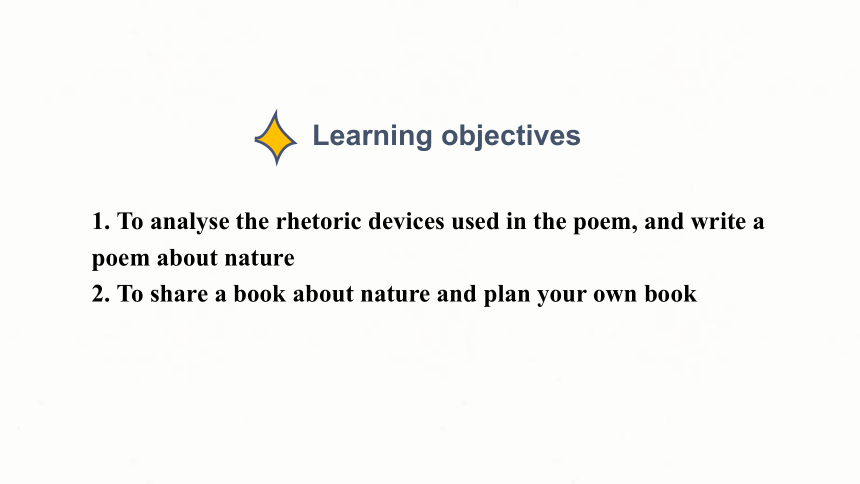
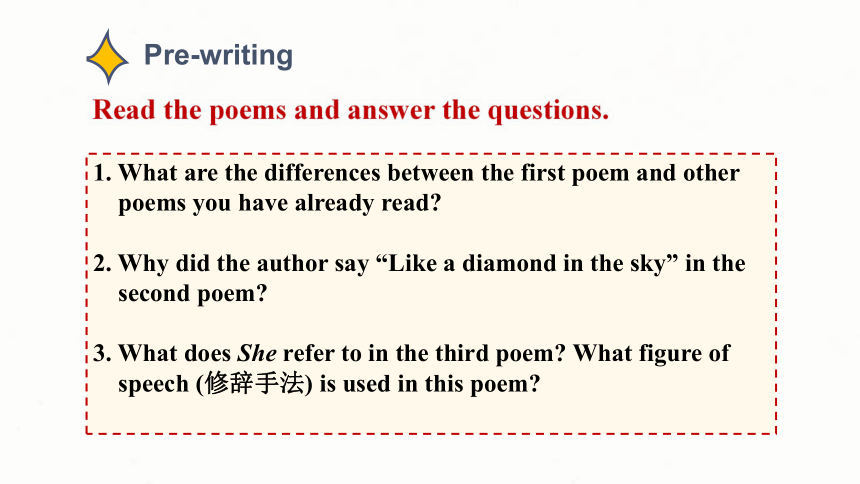
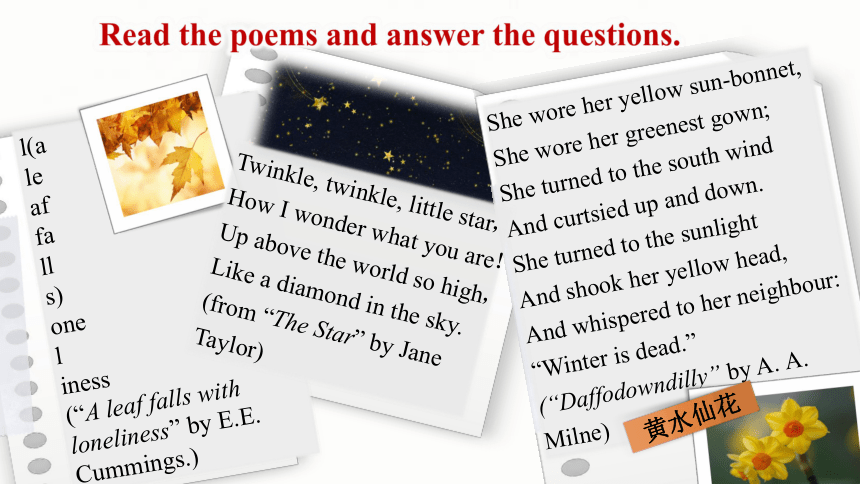
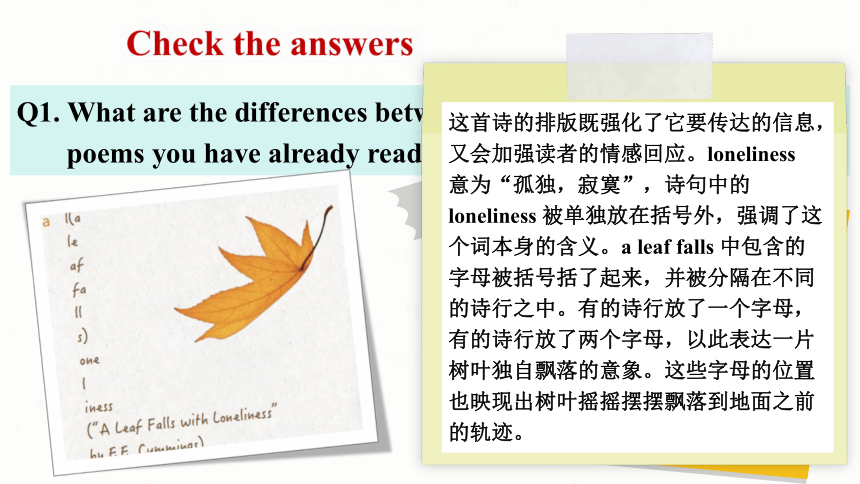
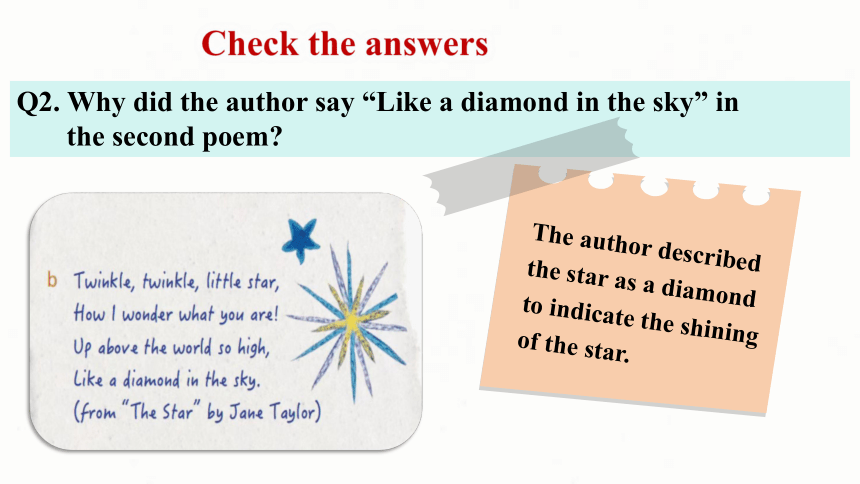

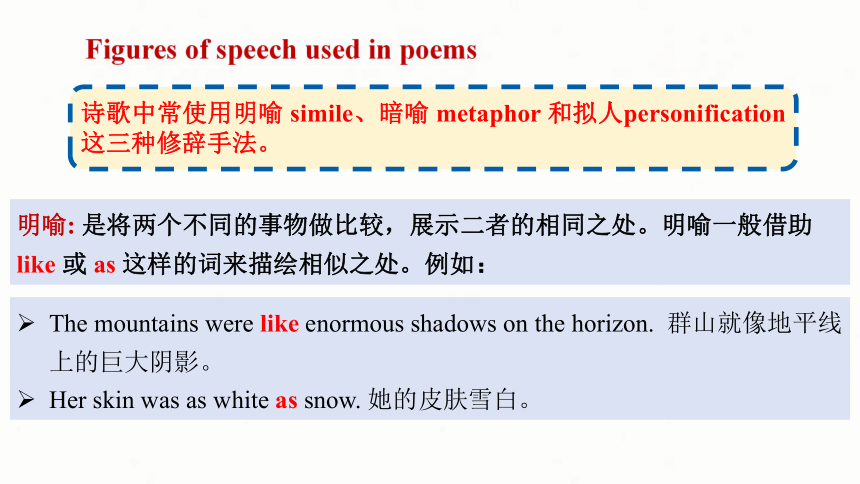
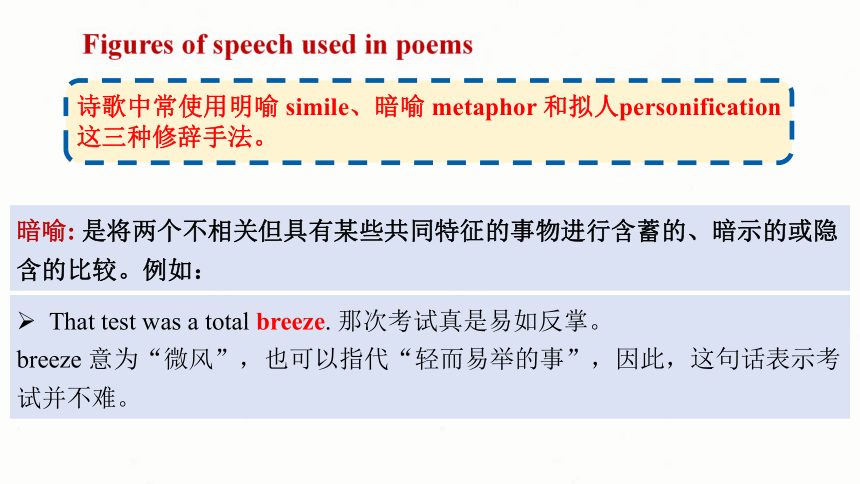
文档简介
(共21张PPT)
Unit 6 Nature in words
Developing ideas
Silent Spring
Learning objectives
1. To analyse the rhetoric devices used in the poem, and write a poem about nature
2. To share a book about nature and plan your own book
Read the poems and answer the questions.
1. What are the differences between the first poem and other
poems you have already read
2. Why did the author say “Like a diamond in the sky” in the
second poem
3. What does She refer to in the third poem What figure of
speech (修辞手法) is used in this poem
Pre-writing
l(a
le
af
fa
ll
s)
one
l
iness
(“A leaf falls with loneliness” by E.E. Cummings.)
Read the poems and answer the questions.
She wore her yellow sun-bonnet, She wore her greenest gown;
She turned to the south wind
And curtsied up and down. She turned to the sunlight
And shook her yellow head, And whispered to her neighbour:
“Winter is dead.”
(“Daffodowndilly” by A. A.
Milne)
Twinkle, twinkle, little star,
How I wonder what you are!
Up above the world so high,
Like a diamond in the sky.
(from “The Star” by Jane Taylor)
黄水仙花
Check the answers
Q1. What are the differences between the first poem and other
poems you have already read
The poem I read before was presented with half a sentence or the whole sentence in a line. However, there are only several letters in a line in this poem.
这首诗的排版既强化了它要传达的信息,又会加强读者的情感回应。loneliness 意为“孤独,寂寞”,诗句中的 loneliness 被单独放在括号外,强调了这个词本身的含义。a leaf falls 中包含的字母被括号括了起来,并被分隔在不同的诗行之中。有的诗行放了一个字母,有的诗行放了两个字母,以此表达一片树叶独自飘落的意象。这些字母的位置也映现出树叶摇摇摆摆飘落到地面之前的轨迹。
Check the answers
Q2. Why did the author say “Like a diamond in the sky” in
the second poem
The author described the star as a diamond to indicate the shining of the star.
Check the answers
Q3. What does She refer to in the third poem What figure of
speech (修辞手法) is used in this poem
In the third poem,She refers to Daffodowndilly. Personification is used in this poem.
诗歌中常使用明喻 simile、暗喻 metaphor 和拟人personification 这三种修辞手法。
明喻: 是将两个不同的事物做比较,展示二者的相同之处。明喻一般借助 like 或 as 这样的词来描绘相似之处。例如:
Figures of speech used in poems
The mountains were like enormous shadows on the horizon. 群山就像地平线上的巨大阴影。
Her skin was as white as snow. 她的皮肤雪白。
诗歌中常使用明喻 simile、暗喻 metaphor 和拟人personification 这三种修辞手法。
暗喻: 是将两个不相关但具有某些共同特征的事物进行含蓄的、暗示的或隐含的比较。例如:
Figures of speech used in poems
That test was a total breeze. 那次考试真是易如反掌。
breeze 意为“微风”,也可以指代“轻而易举的事”,因此,这句话表示考试并不难。
诗歌中常使用明喻 simile、暗喻 metaphor 和拟人personification 这三种修辞手法。
拟人: 是指把人类的情感、欲望、感觉、手势和语言赋予人类以外的事物。这些人类以外的事物可以是物体、事件、动植物等。例如:
Figures of speech used in poems
The branches waved in the wind. 树枝在风中摇曳。
The sun was smiling. 太阳在微笑。
Which poem… a b c
… uses its shape to help convey message
… has rhyming words at the end of lines
… uses metaphor
… uses simile
… uses personification
√
√
√
√
√
√
√
Read the poems again and tick the correct box(es) for each question.
Learning to learn
Rhyme is a typical feature of English poetry. A rhyme is a repetition of similar sounds (or the same sound) in two or more words. Children’s poems, called “nursery rhymes”, usually contain strong rhymes so they are easy to be remembered. In modem poetry, however, features other than rhyme are more important. Lines of modern poetry can be of variable length, the shape of the words on the page is more important, and rhyme is not often used.
While-writing
Think about words and expressions related to nature and add them to the mind map.
NATURE
sky:
the cloudless sky; starry; clusters of stars; …
rainforest:
birds; tropical; broad-leaved trees; humid; animals …
river:
brook / creek; downstream; waterfall; rapid; clear; twist; tranquil …
grassland:
stretches evenly; colorful wild flowers; a green blanket …
mountains:rolling; steep; hilly; snow-capped …
NATURE
sea:
lots of fish; waves; tide; seashore; beach; rough …
Think about words and expressions related to nature and add them to the mind map.
Work in pairs
Plan a poem. Consider the following:
what your poem will be about
what kind of poem you are going to write
what figures of speech you will use
what words you can use for that rhyme (if using
rhyme)
.
Now write your poem
1. Before writing, think about the shape of words on the page.
2. Choose a theme about nature that you are interested in.
3. You had better choose a proper title for your poem.
Exchange drafts
Use the checklist to give feedback on your partner’s draft.
□ Does the poem include the key points
□ Does the poem have proper layout
□ How is the language
□ How is the handwriting
□ How is the paper design
Post-writing
Revise your draft!
Share your review!
There once was a boy who thought,
He could eat all the sweets he had bought.
He gobbled them down, Then started to frown,
'Cause he'd eaten more than he ought.
Reference Text
Homework
Polish your passage and hand it in.
2. Prepare a short presentation about what we can do to protect the natural environment.
Unit 6 Nature in words
Developing ideas
Silent Spring
Learning objectives
1. To analyse the rhetoric devices used in the poem, and write a poem about nature
2. To share a book about nature and plan your own book
Read the poems and answer the questions.
1. What are the differences between the first poem and other
poems you have already read
2. Why did the author say “Like a diamond in the sky” in the
second poem
3. What does She refer to in the third poem What figure of
speech (修辞手法) is used in this poem
Pre-writing
l(a
le
af
fa
ll
s)
one
l
iness
(“A leaf falls with loneliness” by E.E. Cummings.)
Read the poems and answer the questions.
She wore her yellow sun-bonnet, She wore her greenest gown;
She turned to the south wind
And curtsied up and down. She turned to the sunlight
And shook her yellow head, And whispered to her neighbour:
“Winter is dead.”
(“Daffodowndilly” by A. A.
Milne)
Twinkle, twinkle, little star,
How I wonder what you are!
Up above the world so high,
Like a diamond in the sky.
(from “The Star” by Jane Taylor)
黄水仙花
Check the answers
Q1. What are the differences between the first poem and other
poems you have already read
The poem I read before was presented with half a sentence or the whole sentence in a line. However, there are only several letters in a line in this poem.
这首诗的排版既强化了它要传达的信息,又会加强读者的情感回应。loneliness 意为“孤独,寂寞”,诗句中的 loneliness 被单独放在括号外,强调了这个词本身的含义。a leaf falls 中包含的字母被括号括了起来,并被分隔在不同的诗行之中。有的诗行放了一个字母,有的诗行放了两个字母,以此表达一片树叶独自飘落的意象。这些字母的位置也映现出树叶摇摇摆摆飘落到地面之前的轨迹。
Check the answers
Q2. Why did the author say “Like a diamond in the sky” in
the second poem
The author described the star as a diamond to indicate the shining of the star.
Check the answers
Q3. What does She refer to in the third poem What figure of
speech (修辞手法) is used in this poem
In the third poem,She refers to Daffodowndilly. Personification is used in this poem.
诗歌中常使用明喻 simile、暗喻 metaphor 和拟人personification 这三种修辞手法。
明喻: 是将两个不同的事物做比较,展示二者的相同之处。明喻一般借助 like 或 as 这样的词来描绘相似之处。例如:
Figures of speech used in poems
The mountains were like enormous shadows on the horizon. 群山就像地平线上的巨大阴影。
Her skin was as white as snow. 她的皮肤雪白。
诗歌中常使用明喻 simile、暗喻 metaphor 和拟人personification 这三种修辞手法。
暗喻: 是将两个不相关但具有某些共同特征的事物进行含蓄的、暗示的或隐含的比较。例如:
Figures of speech used in poems
That test was a total breeze. 那次考试真是易如反掌。
breeze 意为“微风”,也可以指代“轻而易举的事”,因此,这句话表示考试并不难。
诗歌中常使用明喻 simile、暗喻 metaphor 和拟人personification 这三种修辞手法。
拟人: 是指把人类的情感、欲望、感觉、手势和语言赋予人类以外的事物。这些人类以外的事物可以是物体、事件、动植物等。例如:
Figures of speech used in poems
The branches waved in the wind. 树枝在风中摇曳。
The sun was smiling. 太阳在微笑。
Which poem… a b c
… uses its shape to help convey message
… has rhyming words at the end of lines
… uses metaphor
… uses simile
… uses personification
√
√
√
√
√
√
√
Read the poems again and tick the correct box(es) for each question.
Learning to learn
Rhyme is a typical feature of English poetry. A rhyme is a repetition of similar sounds (or the same sound) in two or more words. Children’s poems, called “nursery rhymes”, usually contain strong rhymes so they are easy to be remembered. In modem poetry, however, features other than rhyme are more important. Lines of modern poetry can be of variable length, the shape of the words on the page is more important, and rhyme is not often used.
While-writing
Think about words and expressions related to nature and add them to the mind map.
NATURE
sky:
the cloudless sky; starry; clusters of stars; …
rainforest:
birds; tropical; broad-leaved trees; humid; animals …
river:
brook / creek; downstream; waterfall; rapid; clear; twist; tranquil …
grassland:
stretches evenly; colorful wild flowers; a green blanket …
mountains:rolling; steep; hilly; snow-capped …
NATURE
sea:
lots of fish; waves; tide; seashore; beach; rough …
Think about words and expressions related to nature and add them to the mind map.
Work in pairs
Plan a poem. Consider the following:
what your poem will be about
what kind of poem you are going to write
what figures of speech you will use
what words you can use for that rhyme (if using
rhyme)
.
Now write your poem
1. Before writing, think about the shape of words on the page.
2. Choose a theme about nature that you are interested in.
3. You had better choose a proper title for your poem.
Exchange drafts
Use the checklist to give feedback on your partner’s draft.
□ Does the poem include the key points
□ Does the poem have proper layout
□ How is the language
□ How is the handwriting
□ How is the paper design
Post-writing
Revise your draft!
Share your review!
There once was a boy who thought,
He could eat all the sweets he had bought.
He gobbled them down, Then started to frown,
'Cause he'd eaten more than he ought.
Reference Text
Homework
Polish your passage and hand it in.
2. Prepare a short presentation about what we can do to protect the natural environment.
